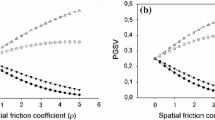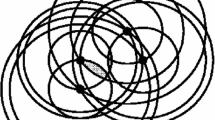Abstract
This paper studies the Pareto optimality properties of policy proposals that are made byk(k≧2) strategic candidates that face uncertainty about the choices that the voters will make. Our first theorem shows that, under very general conditions, any proposal that is a best reply for a candidate is necessarily Pareto optimal. This theorem, in turn, implies that, under slightly stronger conditions, all candidate proposals that are made in a Nash equilibrium or sequentially are necessarily Pareto optimal. Our second theorem shows that, when these conditions are themselves slightly strengthened, any proposal outside of the Pareto set is strictly dominated by at least one proposal inside the Pareto set.
Similar content being viewed by others
References
Bergstrom T (1975) Maximal elements of acyclic relations on compact sets. J Econ Theory 10:403–404
Brown D (1973) Acyclic choice. Cowles Foundation Discussion Paper No. 360. Yale University, New Haven, CT
Chamberlain G, Rothschild M (1981) A note on the probability of casting a decisive vote. J Econ Theory 25:152–162
Cohen L (1979) Cyclic sets in multidimensional voting models. J Econ Theory 20:1–12
Coughlin P (1982) Pareto optimality of policy proposals with probabilistic voting. Publ Choice 39:427–433
Coughlin P (1984) Davis-Hinich conditions and median outcomes in probabilistic voting models. J Econ Theory 34:1–12
Coughlin P, Nitzan S (1981) Directional and local electoral equilibria with probabilistic voting. J Econ Theory 24:226–240
Davis O, Hinich M (1972) Spatial competition under constrained choice. In: Niemi R, Weisberg H (eds) Probabilistic models of collective decision making. CE Merrill, Columbus
Denzau A, Kats A (1977) Expected plurality voting equilibrium and social choice functions. Rev. Econ Studies 44:227–233
Enelow J, Hinich M (1984) The spatial theory of voting: An introduction. Cambridge University Press. Cambridge
Hinich M (1977) Equilibrium in spatial voting: The median voter result is an artifact. J Econ Theory 16:208–219
Hinich M, Ordeshook P (1969) Abstentions and equilibrium in the electoral process. Public Choice 7:208–219
Hinich M, Ledyard J, Ordeshook P (1972) Nonvoting and the existence of equilibrium under majority rule. J Econ Theory 4:144–153
Kramer G (1977) A dynamical model of political equilibrium. J Econ Theory 16:310–334
Ledyard J (1981) The paradox of voting and candidate competition: A general equilibrium Analysis. In: Horwich G, Quirk J (eds) Essays in contemporary fields of economics. Purdue University Press, West Lafayette
Ledyard J (1985) The pure theory of large two candidate elections. Publ Choice 44:7–41
McKelvey R (1975) Policy related voting and electoral equilibrium. Econometrica 43:815–844
McKelvey R (1976) Intransitivities in multidimensional voting models and some implications for agenda control. J Econ Theory 12:472–482
McKelvey R (1979) General conditions for global intransitivities in formal voting models. Econometrica 47:1085–1112
McKelvey R, Ordeshook P (1976) Symmetric spatial games without majority rule equilibria. Am Polit Sci Rev 70:1172–1184
Moulin H (1982) Game theory for the social sciences. NYU Press, New York
Mueller D (1979) Public choice. Cambridge University Press, Cambridge
Ordeshook P (1971) Pareto optimality and electoral competiton. Am Polit Sci Rev 65:1141–1145
Palfrey T, Rosenthal H (1983) A strategic calculus of voting. Public Choice 41:7–53
Riker W, Ordeshook P (1973) An introduction to positive political theory. Prentice-Hall, Englewood Cliffs, NJ
Shubik M (1968) A two party system, general equilibrium, and the voters' paradox. Z Nationalökonomie 28:341–354
Slutsky S (1975) Abstentions and majority equilibrium. J Econ Theory 11:292–304
Walker M (1977) On the existence of maximal elements. J Econ Theory 16:470–474
Wittman D (1977) Candidates with policy preferences: A dynamic model. J Econ Theory 14:180–189
Author information
Authors and Affiliations
Additional information
We would like to acknowledge helpful comments and suggestions provided by Otto Davis and Richard McKelvey
Rights and permissions
About this article
Cite this article
Coughlin, P.J., Palfrey, T.R. Pareto optimality in spatial voting models. Soc Choice Welfare 1, 307–319 (1985). https://doi.org/10.1007/BF00649266
Received:
Accepted:
Issue Date:
DOI: https://doi.org/10.1007/BF00649266




